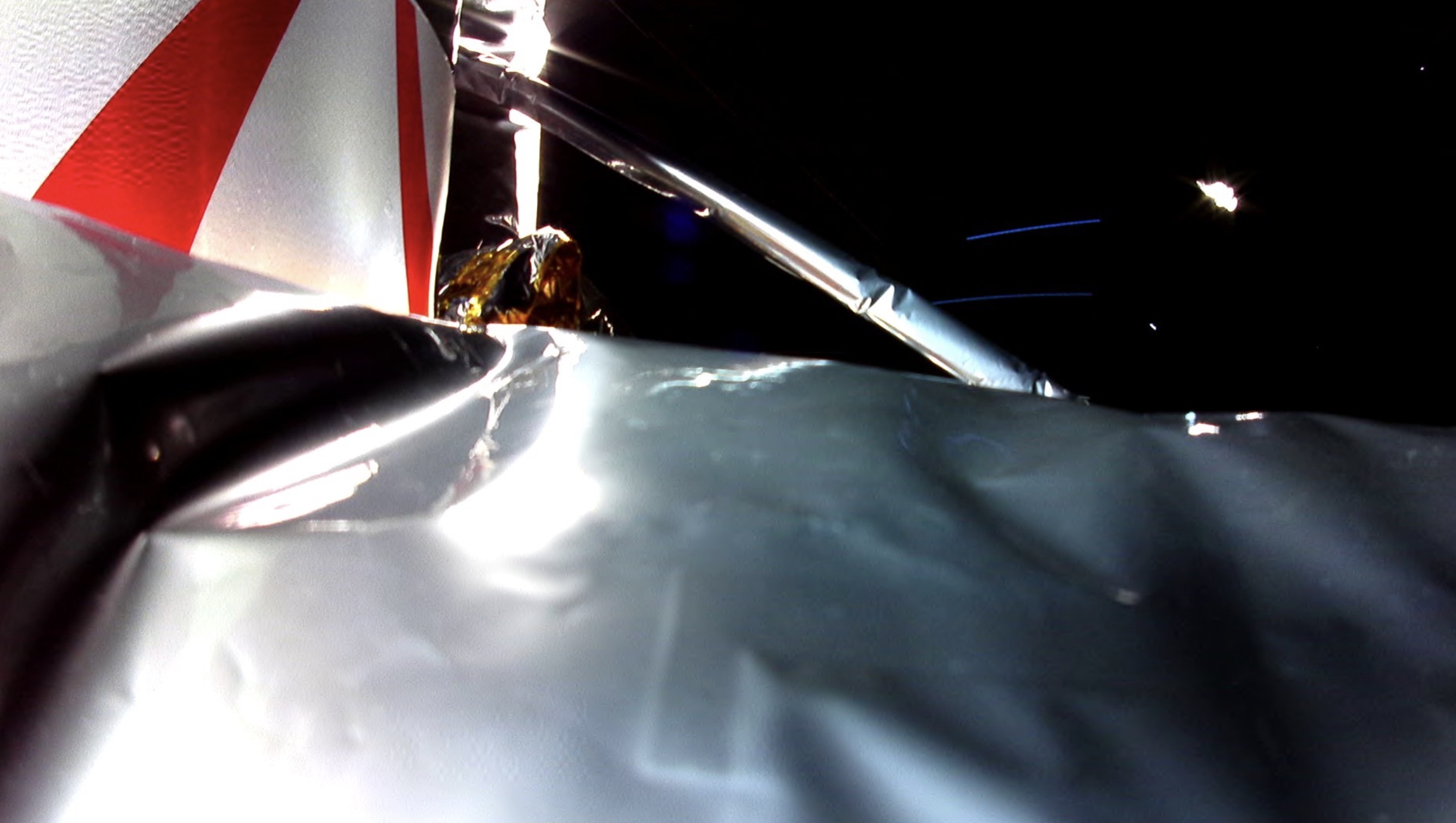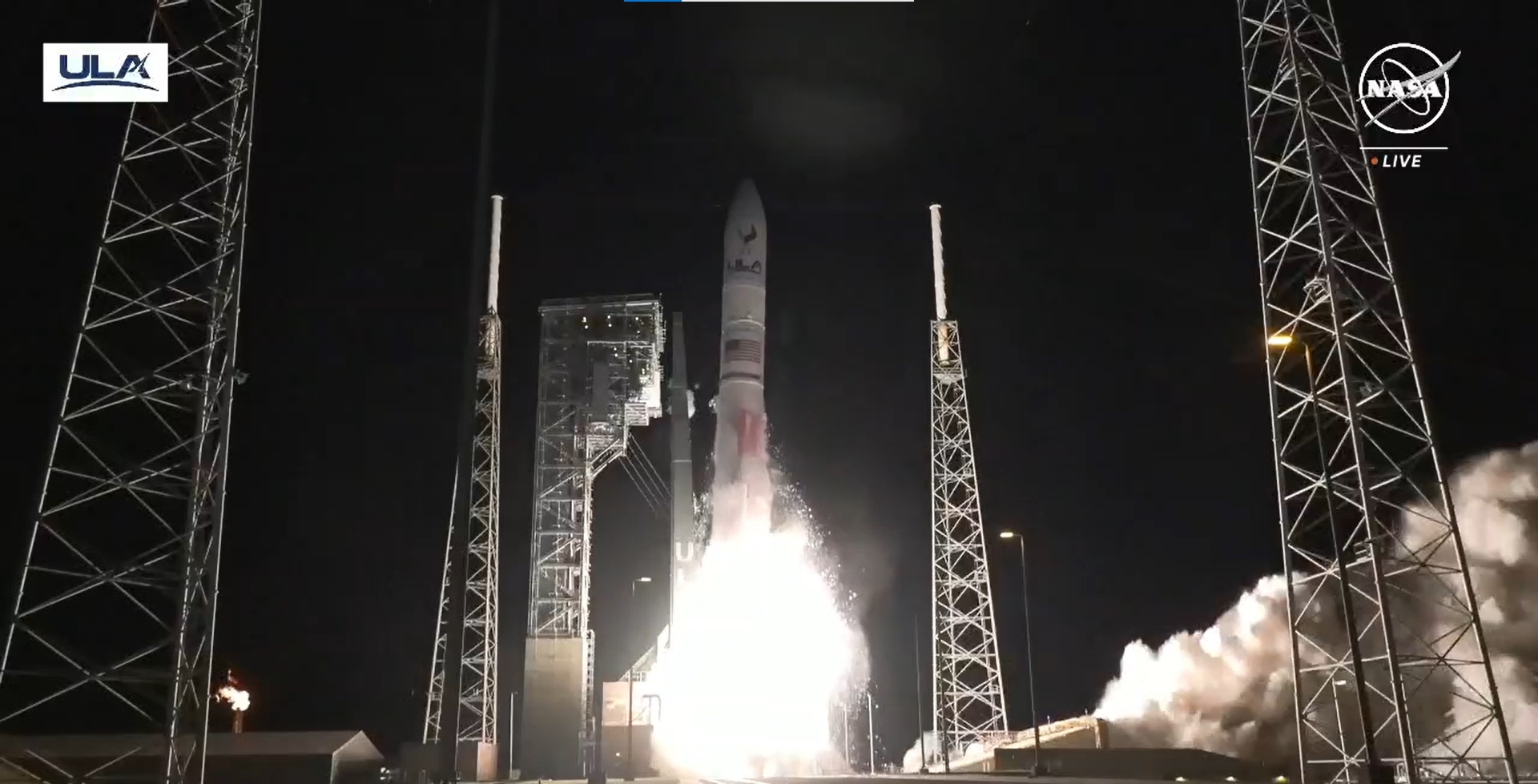We’ve received the first image from Peregrine in space! The camera utilized is mounted atop a payload deck and shows Multi-Layer Insulation (MLI) in the foreground.
The disturbance of the MLI is the first visual clue that aligns with our telemetry data pointing to a propulsion system anomaly.
Nonetheless, the spacecraft’s battery is now fully charged, and we are using Peregrine’s existing power to perform as many payload and spacecraft operations as possible.
At this time, the majority of our Peregrine mission team has been awake and working diligently for more than 24 hours. We ask for your patience as we reassess incoming data so we can provide ongoing updates later this evening.
As part of NASA’s Commercial Lunar Payload Services initiative, Astrobotic’s Peregrine lander launched on United Launch Alliance’s (ULA) Vulcan rocket at 2:18 a.m. EST from Launch Complex 41 at Cape Canaveral Space Force Station in Florida.
Once on the Moon, NASA instruments will study the lunar exosphere, thermal properties of the lunar regolith, hydrogen abundances in the soil at the landing site, and conduct radiation environment monitoring. The five NASA science and research payloads aboard the lander will help the agency better understand planetary processes and evolution, search for evidence of water and other resources, and support long-term, sustainable human exploration.
“The first CLPS launch has sent payloads on their way to the Moon – a giant leap for humanity as we prepare to return to the lunar surface for the first time in over half a century,” said NASA Administrator Bill Nelson. “These high-risk missions will not only conduct new science at the Moon, but they are supporting a growing commercial space economy while showing the strength of American technology and innovation. We have so much science to learn through CLPS missions that will help us better understand the evolution of our solar system and shape the future of human exploration for the Artemis Generation.”
Peregrine is scheduled to land on the Moon on Friday, Feb. 23, and will spend approximately 10 days gathering valuable scientific data studying Earth’s nearest neighbor and helping pave the way for the first woman and first person of color to explore the Moon under Artemis.
WASHINGTON, - A robotic lander built by a private company suffered a propulsion system issue on its way to the moon on Monday, upending the first U.S. soft lunar landing attempt in over 50 years as mission managers scrambled to fix its position in space.
Space robotics firm Astrobotic Technology's Peregrine lunar lander had launched successfully to space at 2:18 a.m. ET from Cape Canaveral, Florida, aboard the first flight of Vulcan, a rocket that had been under development for a decade by the Boeing (BA.N) and Lockheed Martin (LMT.N) joint venture United Launch Alliance (ULA).
But hours after separating from Vulcan, Astrobotic said issues with Peregrine's propulsion system briefly prevented the spacecraft from angling itself toward the sun for power.
While mission engineers regained control, the faulty propulsion system is losing valuable propellant, forcing Astrobotic to consider "alternative mission profiles," suggesting a moon landing is no longer achievable.
The launch of Vulcan, a 200-foot (60-meter) tall rocket with engines made by Jeff Bezos' Blue Origin, was a crucial first for ULA, which developed Vulcan to replace its workhorse Atlas V rocket and rival the reusable Falcon 9 from Elon Musk's SpaceX in the satellite launch market.
The stakes of the mission were high for Vulcan. Boeing and Lockheed, which own ULA in a 50-50 split, have been seeking a sale of the business for roughly a year. The launch was the first of two certification flights required by the U.S. Space Force before Vulcan can fly lucrative missions for the Pentagon, a key customer.
A successful launch of the moon lander, which ULA agreed to fly at a roughly 50% discount given the risks of flying on a new rocket, allows the company to start fulfilling a multibillion-dollar backlog of some 70 missions booked already. Vulcan sells for at least $110 million per launch.
Vulcan's placement of the Peregrine lander into orbit was "dead on bullseye," ULA CEO Tory Bruno said. "This has been years of hard work," he added from the company's launch control room after launch.
But the lander itself, after being released from the rocket, failed to enter its correct sun-facing orientation in space and saw its battery levels plummet, hours after it made successful contact with ground teams and activated its propulsion system, Astrobotic said in a statement.
As Astrobitc was working to confirm the propulsion system issue, it said such a problem "threatens the ability of the spacecraft to soft land on the moon."
t said in a later update that engineers had regained control of the spacecraft to allow it to charge its batteries. While Peregrine remains in Earth's orbit, "we have prioritized maximizing the science and data we can capture," Astrobotic said.
Setting off for a 46-day trek on Monday, Peregrine was poised to mark the first U.S. soft landing on the moon since the final Apollo mission in 1972, and the first-ever lunar landing by a private company - a feat that has proved elusive in recent years.
"This is the moment we've been waiting for for 16 years," Astrobotic CEO John Thornton said after the lander's launch.
Peregrine was set to land on the moon on Feb. 23 with 20 payloads aboard, most of which were designed to gather data about the lunar surface ahead of planned future human missions. If successful, it would mark the first trek to the moon's surface as part of NASA's Artemis moon program.
That multibillion-dollar program, involving various countries and relying heavily on private companies such as SpaceX, envisions astronaut missions to the moon later this decade. Small landers such as Peregrine are expected to get there first.
A second private U.S. company under the same NASA program expects to launch a lander of its own in February. Carrying similar NASA payloads and launching to space aboard a SpaceX Falcon 9, Houston-based Intuitive Machines' said its spacecraft could make a moon landing on Feb. 22, a day before Peregrine's planned arrival.
India last year became the fourth country to achieve a soft lunar landing after Russia failed in an attempt the same month. The U.S., China and the former Soviet Union are the only other countries that have carried out successful soft lunar landings.
Private companies with hopes of spurring a lunar marketplace have had harder times, with Japan's ispace and an Israeli company crash-landing on their first attempts.
Peregrine likely won't be the first private spacecraft to touch down on the moon.
It looks like Astrobotic's Peregrine lander won't win the private moon race.
The spacecraft suffered a serious anomaly in its propulsion system today (Jan. 8), shortly after being deployed into space by United Launch Alliance's (ULA) new Vulcan Centaur rocket. The problem will apparently keep Peregrine from journeying to the moon as planned.
"Unfortunately, it appears the failure within the propulsion system is causing a critical loss of propellant. The team is working to try and stabilize this loss, but given the situation, we have prioritized maximizing the science and data we can capture. We are currently assessing what alternative mission profiles may be feasible at this time," Pittsburgh-based Astrobotic wrote today in an update on X(formerly known as Twitter).
Peregrine's launch today was a big moment in spaceflight. It marked the flawless debut of the powerful Vulcan Centaur, which will replace ULA's workhorse Atlas V and Delta rockets. And it opened a new era of private moon exploration — or was supposed to, anyway.
Peregrine flew as part of NASA's Commercial Lunar Payload Services (CLPS) program, which puts agency science payloads on private robotic moon craft. Five NASA payloads were aboard the lander on this flight, including a radiation detector and several spectrometers, one of which was designed to hunt for evidence of subsurface water ice.
NASA thinks that leveraging private spacecraft in this way will allow it to perform a variety of lunar research quickly and cost-effectively, helping the agency prep for crewed missions to the moon under its Artemis program. NASA also hopes that CLPS boosts the capabilities of the American private space sector and stimulates a growing off-Earth economy.
That said, NASA officials have stressed that each CLPS mission is a high-risk, high-reward proposition. No private spacecraft has ever landed successfully on the moon, after all, so some failures along the way are to be expected.
Indeed, the agency seems to be taking Peregrine's current plight in stride.
"Each success and setback are opportunities to learn and grow," Joel Kearns, deputy associate administrator for exploration at NASA's Science Mission Directorate in Washington, said in an emailed statement today. "We will use this lesson to propel our efforts to advance science, exploration and commercial development of the moon."
The NASA experiments aren't the only payloads that Peregrine was supposed to carry to the moon. The lander totes a total of 20 payloads, including Mexico's first lunar probes and a memorial capsule from the space-burial company Celestis.
The memorial capsule's inclusion drew objections from the Navajo Nation, whose president said that depositing human remains on the moon would desecrate a body considered sacred by many Indigenous peoples.
Celestis also put a separate memorial payload on Vulcan Centaur's upper stage, which carried it into orbit around the sun. This second payload, called Enterprise, carries a portion of the cremated remains of several "Star Trek" icons, including series creator Gene Roddenberry and his wife Majel Barrett Roddenberry, Nichelle Nichols (who played Uhura) DeForest Kelley (Bones McCoy) and James Doohan (Scotty).
The Enterprise payload also features the DNA of other notable people, including former U.S. presidents George Washington, Dwight Eisenhower, John F. Kennedy, and Ronald Reagan.
The next private moon lander to lift off under NASA's CLPS program is Nova-C, which was built by Houston-based company Intuitive Machines.
Nova-C is scheduled to launch atop a SpaceX Falcon 9 rocket in mid-Februaryand land near the moon's south pole not long afterward.
Quelle: SC
----
Update: 11.01.2024
.
Fuel leak on Astrobotic's moon lander leaves 'no chance' of soft landing
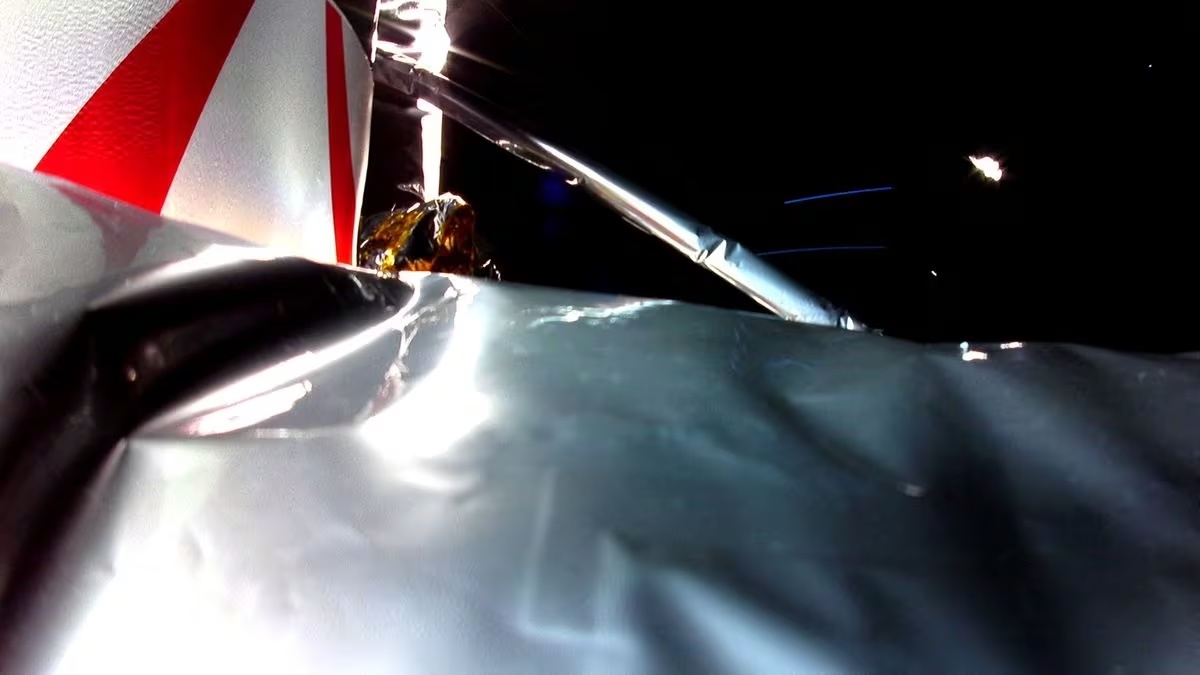
Space robotics firm Astrobotic Technology's Peregrine lunar lander is seen with a disturbance of its Multi-Layer Insulation (MLI), after its launch aboard the first flight of Vulcan, a rocket that had been under development for a decade by the Boeing and Lockheed Martin joint venture United Launch Alliance (ULA) January 8, 2024. Astrobotic Technology
WASHINGTON, Jan 9 (Reuters) - Astrobotic's Peregrine lunar lander has "no chance" of a soft landing on the moon after springing a propellant leak in the first few hours of its journey in space, the company said on Tuesday about the first such U.S. attempt in five decades.
There was 40 hours of fuel left on the lander that will allow it to operate "as a spacecraft" even as engineers determine what its new mission in orbit will be, the space robotics firm said.
The craft was launched aboard the first flight of Vulcan, a rocket that had been under development for a decade by United Launch Alliance (ULA), a joint venture of Boeing (BA.N) and Lockheed Martin (LMT.N).
The lander was launched successfully at 2:18 a.m. ET on Monday from Cape Canaveral, Florida, but it suffered a propulsion system issue enroute to the moon.
After the launch, the lander failed to enter its correct sun-facing orientation in space and saw its battery levels plummet, but Astrobotic was able to fix the issue, the company said.
"The team continues to work to find ways to extend Peregrine's operational life," it said, adding that engineers are receiving data and proving spaceflight operations for components and software related to its next lunar lander mission.
Quelle: Reuters
+++
Astrobotic says its Peregrine lunar lander won't make planned soft landing on the moon due to propellant
leak
The Peregrin lunar lander, crippled by a propellant leak shortly after launch early Monday, is now expected to run out of fuel Thursday and will not be able to carry out its planned landing on the lunar surface, officials said Tuesday.
"Given the propellant leak, there is, unfortunately, no chance of a soft landing on the moon," Astrobotic, the Pittsburgh-based builder of the spacecraft, said in a post on X. "However, we do still have enough propellant to continue to operate the vehicle as a spacecraft.
"The team continues to work to find way to extend Peregrine's operational life. We are in stable operating mode and are working payload and spacecraft tests and checkouts. We continue receiving valuable data and proving spaceflight operations for components and software relating to our next lunar landing mission."
That spacecraft, known as Griffin, is a larger, more capable lunar lander scheduled to carry a NASA rover to the moon later this year. Astrobotic said lessons learned during Peregrine's abbreviated flight will be built into the new spacecraft.
The Peregrine lander was the first American spacecraft bound for the surface of the moon in more than 50 years and only the third developed as a non-government commercial venture. Two previous commercial attempts, one launched in 2019 by an Israeli group and the other in 2023 by a Japanese company, ended in crash landings on the moon.
The latest private-sector moon missions are funded under a NASA program -- the Commercial Lunar Payload Services program or CLPS -- intended to spur development of lunar transportation and surface delivery services for hire.
NASA paid Astrobotic $108 million dollars to deliver five sophisticated science instruments and a navigation sensor to the moon aboard Peregrine. The company has not yet said what might have gone wrong with Peregrine to trigger the propellant leak.
Astrobotic's Griffin, scheduled for launch later this year atop a SpaceX Falcon Heavy rocket, will carry a NASA rover to the south polar region of the moon to search for signs of ice in the lunar environment.
Quelle: CBS News
----
Update: 12.01.2024
.
Astrobotic gets payloads working on ailing Peregrine lander

An image from Astrobotic’s Peregrine lunar lander shows the wheels of IRIS, a lunar rover from Carnegie Mellon University. Credit: Astrobotic
NEW ORLEANS — Astrobotic, which is working to squeeze as much life as possible out of its crippled Peregrine lunar lander, says it has obtained data from many of the payloads on the spacecraft.
The company said Jan. 11 that it provided power to, and received data from, nine of the 20 payloads on the lander. They include four NASA science experiments included on the lander as part of Commercial Lunar Payload Services (CLPS) program: the LETS radiation instrument and the NIRVSS, NSS and PITMS spectrometers. The fifth, a laser retroreflector, is passive and does not have power or data requirements.
NASA, in a separate statement, said it was using LETS and NSS to measure the radiation environment in cislunar space. The joint observations “provide complementary insights into the galactic cosmic ray activity and space weather resulting from solar activity.”
“Measurements and operations of the NASA-provided science instruments on board will provide valuable experience, technical knowledge, and scientific data to future CLPS lunar deliveries,” said Joel Kearns, deputy associate administrator for exploration in NASA’s Science Mission Directorate.
A NASA technology demonstration payload, the Navigation Dopplar Lidar, is also powered up and generating data. Other payloads that are active and generating data include the IRIS lunar rover from Carnegie Mellon University, the COLMENA micro-rovers from Mexico’s space agency AEM, the M-42 radiation detector from German aerospace center DLR and Astrobotic’s own Optical Precision Autonomous Landing sensor.
A tenth payload, the Lunar Dream Time Capsule from Japan’s Astroscale and Pocari Sweat, is powered up but does not generate data. The other payloads on Peregrine are passive.
“These payloads have now been able to prove operational capability in space and payload teams are analyzing the impact of this development now,” the company said in a statement. “We are proud of the mission team for achieving this incredible feat under such challenging circumstances.”
Those challenging circumstances involve a propellant leak that started after initialization of the lander’s propulsion system shortly after its Jan. 8 launch on the first United Launch Alliance Vulcan Centaur. That leak caused attitude control problems for the spacecraft and ruled out any chance of attempting a soft landing on the moon in February as originally planned.
In a Jan. 9 update, Astrobotic said its current hypothesis for the propellant link involved a valve in a helium pressurization system that failed to close after an initial test. “This led to a rush of high-pressure helium that spiked the pressure in the oxidizer tank beyond its operating limit and subsequently ruptured the tank,” the company stated. It added that it had no reason to believe the problem was linked to the launch.
The leak will limit the lifetime of the lander; when it runs out of propellant the spacecraft will no longer be able to stabilize itself and point its solar panels at the sun, depriving it of power. The company has been able to stretch out those fuel reserves, and as of late Jan. 10 estimated there were 36 hours’ worth of fuel remaining.
The company said late Jan. 11 that engineers now estimated the spacecraft had enough propellant for 48 hours of operations, an increase it credited to a slowing leak rate. “A slowing leak rate is expected as the pressure drops, but there may be some change in the size of the propulsion system’s rupture as the pressure decreases or some other factor making it difficult to predict,” the company stated.
Quelle: SN
----
Update: 14.01.2024
.
NASA to Join Astrobotic’s Media Call on Peregrine Mission One Status

NASA will join an Astrobotic media teleconference at 12 p.m. EST, Thursday, Jan. 18, to discuss updates on their Peregrine Mission One, which is carrying science for the agency as part of its Commercial Lunar Provider Services (CLPS) initiative.
The audio-only teleconference will stream live on the agency’s website.
Following a successful launch on Jan. 8, Astrobotic’s Peregrine lander experienced a propulsion issue after the spacecraft entered its operational state. This is preventing Astrobotic from achieving a soft landing on the Moon. Aboard the Peregrine spacecraft are five NASA science instruments, several of which are receiving power and gathering data.
Participants on the call include:
- Joel Kearns, deputy associate administrator for Exploration, Science Mission Directorate at NASA Headquarters in Washington
- John Thornton, CEO, Astrobotic, Pittsburgh
To participate in the teleconference, media must RSVP online no later than two hours before the start of the call to Astrobotic.
Learn more about CLPS at:
https://nasa.gov/clps
-end-
Quelle: NASA
----
Update: 16.01.2024
.
Ailing Peregrine moon lander on path to crash into Earth, Astrobotic says
Peregrine will likely burn up in Earth's atmosphere, the moon lander's builder said.
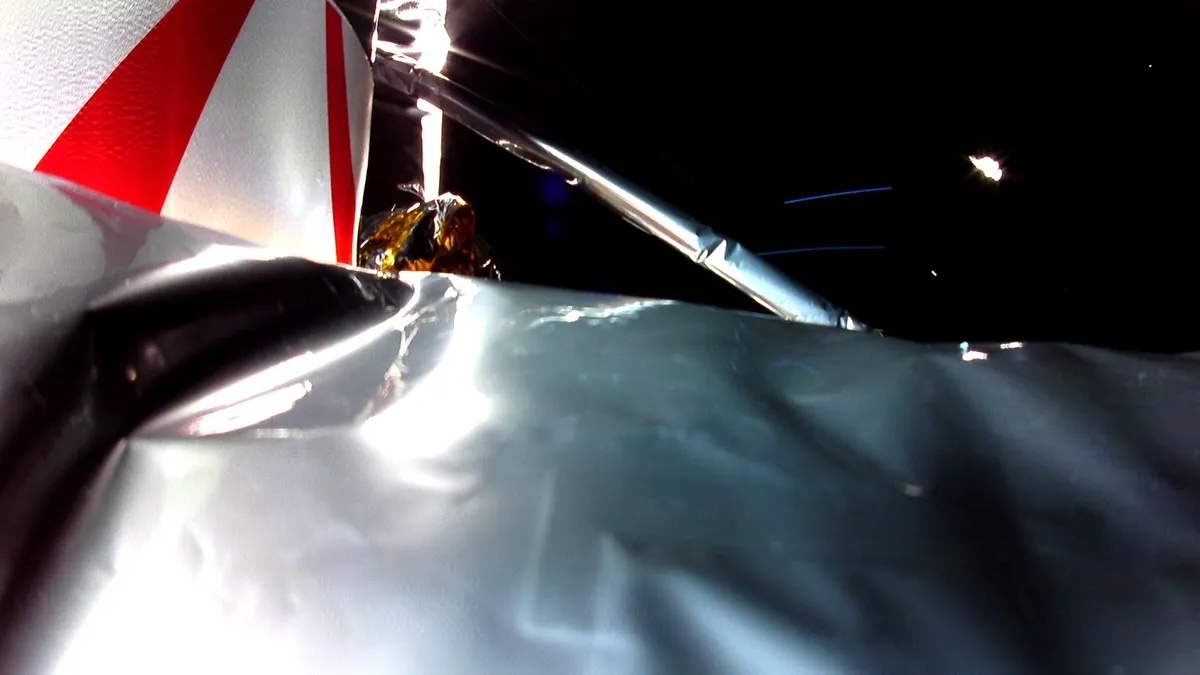
The first photo snapped by Astrobotic's Peregrine moon lander in space, shared via X on Jan. 8, 2024.(Image credit: Astrobotic via X)
The beleaguered private moon lander Peregrine, which suffered a fuel leak shortly after its launch last week, is now on a collision course with Earth, its builder said Saturday (Jan. 13).
Peregrine launched toward the moon on Jan. 8 atop a United Launch Alliance Vulcan Centaur rocket, but suffered a critical fuel leak shortly after separating from the booster. That loss of fuel doomed Peregrine's chances to soft-land on the moon next month, according to its builder Astrobotic. While the company has been fighting to keep the lander alive as long as possible, the probe's days are definitely numbered due to its trajectory, Astrobotic said.
"Our analysis efforts have been challenging due to the propellant leak, which have been adding uncertainty to predictions of the vehicle's trajectory," Astrobotic wrote in an update on X (formerly Twitter) on Saturday. "Our latest assessment now shows the spacecraft is on a path towards Earth, where it will likely burn up in Earth's atmosphere."
Astrobotic did not include an expected date for when Peregrine could slam into Earth's atmosphere, though the Pittsburgh-based company's engineers continue work to salvage the spacecraft.
"The team is currently assessing options and we will update as soon as we are able," Astrobotic wrote in the update. On Sunday, Peregrine was about 242,000 miles (389,000 kilometers) from Earth, just beyond the orbit of the moon, which circles Earth at about 238,000 miles (384,400 km).
Astrobotic's Peregrine lander is the first U.S. private moon lander ever to launch and the first to carry NASA experiments and commercial payloads to the moon, as well as the first mission to fly under NASA's Commercial Lunar Payloads Services program. It is carrying five NASA experiments and 15 other payloads for a variety of customers, including human remains intended for a moon burial for the companies Celestis and Elysium Space.
The Peregrine lander was slated to attempt its moon landing on Feb. 23, but the fuel leak made that impossible, Astrobotic said as the situation developed. In recent days, the leak has slowed, allowing engineers to extend its life.
"The propellant leak has slowed considerably to a point where it is no longer the team's top priority," Astrobotic said in its update, adding that a soft moon landing was still not possible.
Astrobotic officials and NASA are expected to hold a press conference on Thursday (Jan. 18) to discuss the mission's status.
Quelle: SC
----
Update: 20.01.2024
.
Astrobotic’s lunar lander falls into South Pacific after missing out on moon landing
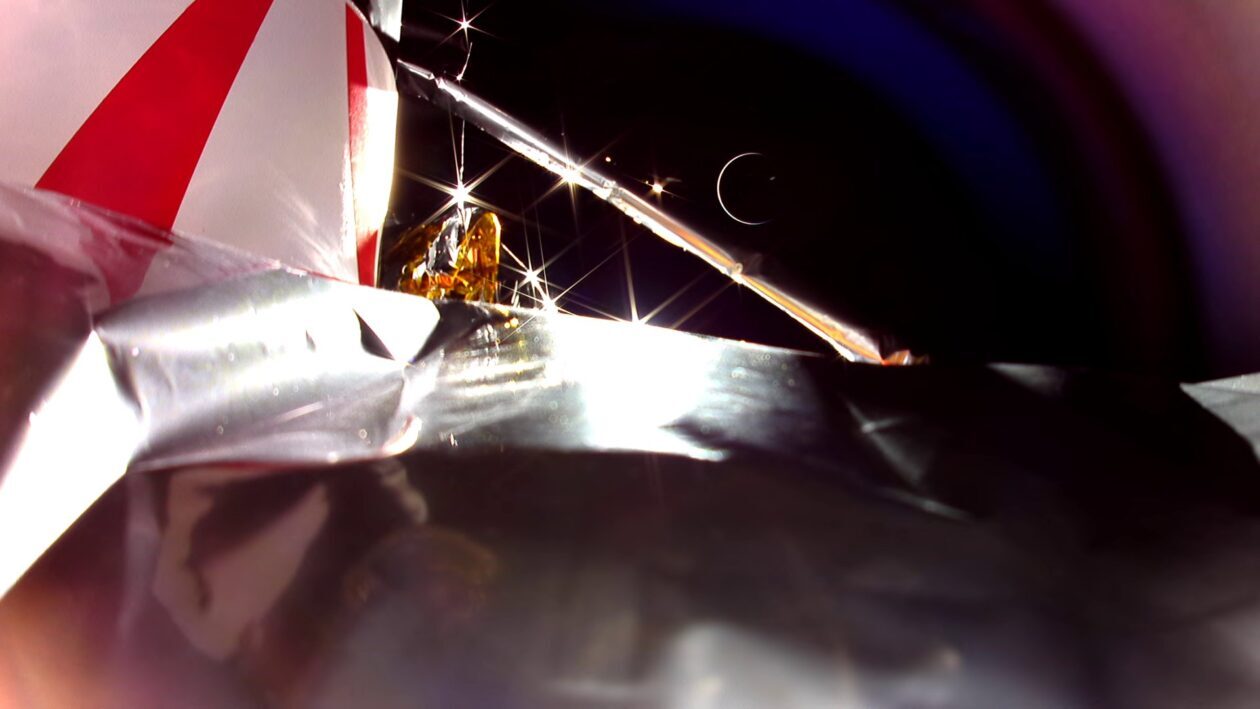
One of the last pictures taken by a camera on the Peregrine lander shows a crescent Earth. (Astrobotic Photo)
Ten days after its launch, Astrobotic’s Peregrine lunar lander fell back to Earth today, ending a trip to the moon’s orbital distance and back that was doomed by a propellant leak.
The mission began auspiciously on the night of Jan. 7-8 with a seemingly successful liftoff from Florida on United Launch Alliance’s first Vulcan Centaur rocket, powered by Blue Origin’s BE-4 rocket engines. But hours after launch, the Pittsburgh-based Astrobotic team detected a problem with the propulsion system. So much propellant was lost that the team had to rule out a moon landing.
After days of troubleshooting, Astrobotic and NASA determined that the best course was to send the 8-foot-wide robotic spacecraft on a looping orbit that went out more than 240,000 miles from Earth — and then came back for a controlled re-entry over a remote area of the South Pacific.
Based on telemetry received during Peregrine’s approach, Astrobotic and NASA said the lander should have re-entered the atmosphere around 1 p.m. PT. In an update posted to X / Twitter, Astrobotic said it lost contact with the spacecraft at around 12:50 p.m. PT, which suggested that re-entry occurred at 1:04 p.m. in line with predictions. Astrobotic also took a walk down memory lane, posting a video that was captured moments after last week’s spacecraft separation. “Background: our big blue marble, Earth!” the posting read.
Earlier today, Peregrine sent back what Astrobotic called “a stunning image” of a crescent Earth, captured by one of the lander’s cameras from a distance of more than 30,000 miles.
“The first attempt to take this photo yielded an oversaturated image, with the sun making the image too bright to see the Earth,” Astrobotic said in a posting on X / Twitter. “As a result, the team precisely slewed the spacecraft to reposition the sun to be hidden behind the think payload deck strut just to the left of Earth, which produced the starburst effects on the video and revealed the Earth’s crescent.”
Astrobotic said the image was dedicated “to our customers, partners and team who all stood with us throughout Peregrine Mission One.”
Further details about the end of Peregrine Mission One will be provided during a briefing planned by Astrobotic and NASA at 10 a.m. PT Friday, and we’ll update this story with information from that briefing.
The Peregrine lander’s primary payload was a suite of NASA science instruments that would have gathered data about the environment around the lunar landing site. Today, the space agency said that “all NASA payloads designed to power on have received power and collected data,” and that observations were made relating to the radiation environment and chemical compounds in the vicinity of the lander during its transit through space.
NASA was due to pay Astrobotic $108 million to deliver its science payloads to the lunar surface, but it’s not clear how much it will end up paying for a mission that wasn’t fully successful.
Peregrine was also carrying more than a dozen non-NASA payloads — including a mini-rover and micro-robots, a “Lunar Library” carrying the equivalent of 60 million pages of information, DNA data archives, memorabilia and capsules of cremated remains. All those payloads were lost during re-entry.
If the mission had been successful, Peregrine would have been the first commercial lander to touch down safely on the moon, and the first U.S.-built spacecraft to make a soft lunar landing since the Apollo 17 mission in 1972.
The next spacecraft in line to go after those distinctions is Intuitive Machines‘ Nova-C lander, which is due to be launched to the moon’s south polar region on a SpaceX Falcon 9 rocket as early as next month.
As was the case for Peregrine, NASA is paying Intuitive Machines to deliver hardware to the lunar surface under the aegis of the space agency’s Commercial Lunar Payload Services program, or CLPS. Another CLPS-supported mission calls for Astrobotic to deliver NASA’s VIPER rover to a landing spot near the moon’s south pole late this year.
Quelle: GeekWire
----
Update: 23.01.2024
.
Japan’s successful Moon landing was the most precise ever
Landing within 100 metres of its target zone, the craft has pioneered a new image-based automatic navigation. But its mission might be cut short.
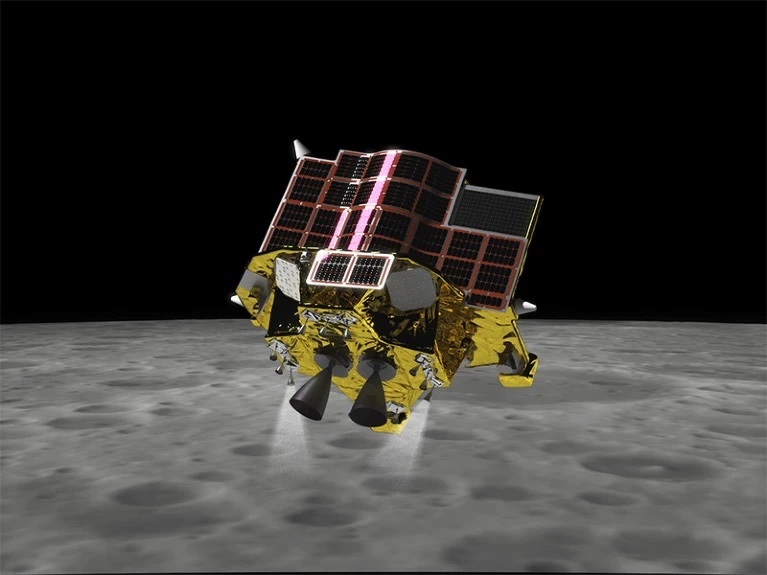
Japan has become the fifth country in the world to soft-land a spacecraft on the Moon, using precision technology that allowed it to touch down closer to its target landing site than any mission has before. However the spacecraft might have survived on the lunar surface for just a few hours due to power failure.
Telemetry showed that the Smart Lander for Investigating Moon, or SLIM, touched down in its target area near Shioli crater, south of the lunar equator early Saturday morning, four months after lifting off from the Tanegashima Space Centre, off the south coast of Japan.
“SLIM has made it to the Moon’s surface. It has been communicating with our ground station and responding to commands from Earth accurately,” Hitoshi Kuninaka, vice president of Kanegawa-based Japan Aerospace Exploration Agency (JAXA), told a press conference after the landing was completed.
“However, it seems that the solar cells are not generating electricity at this point, and the spacecraft is operating solely on its battery,” Kuninaka said. “The battery will last several more hours — those hours will be the remaining life of SLIM.” He said the agency would continue monitoring the lander, as there was still a chance the panels would start working.
The successful landing comes around two weeks after a commercial US spacecraft launchedfor the Moon, only to discover a propellant problem that means it won’t be able to land as planned. It’s also almost a year since a Japanese commercial lander crashed into the Moon in failure; Moon landings are notoriously difficult to pull off and a commercial company has yet to do so.
Namrata Goswami, a space policy researcher at Arizona State University in the United States says the successful landing is “a big win for Asia”. Only China, India, and Japan have put a spacecraft on the Moon in the past decade. India successfully landed in August 2023.
Innovative technology
According to Kuninaka, SLIM has very likely achieved its primary goal — to land on the Moon with an unprecedented accuracy of 100 metres, which is a big leap from previous ranges of a few to dozens of kilometres. SLIM carried vision-based navigation technology, which was intended to image the surface as it flew over the Moon, and locate itself quickly by matching the images with onboard maps.
It remains unclear if the car-sized, 200-kilogram spacecraft actually touched down in the planned, two-step manner with its five legs. Unlike previous Moon landers, which used four legs to simultaneously reach a relatively flat area, SLIM was designed to hit a 15-degree slope outside Shioli crater first with one leg at the back, and then tip forward to stabilize on the four front legs.
Observers suggest that SLIM might have rolled during its touch-down, preventing its solar cells from facing the Sun. Kuninaka said not enough data were available to establish the probe’s posture or orientation. However, if some sunlight is able to reach the solar cells there is a chance that SLIM could come back to life.
An additional two small robots were intended to eject from SLIM before touch-down according to Kuninaka. They were supposed to take images of the lander and return them to Earth, but at this stage it’s unclear whether they deployed.
If SLIM can come back to life, scientists plan to use a specialized camera — the only scientific instrument onboard — to look for a mineral called olivine in the Moon’s mantle. “If we can detect the olivine’s components and compare it with its counterpart on Earth, it may offer new evidence to support the theory that the Moon was part of Earth long time ago,” says Shinichiro Sakai, the mission’s project manager at JAXA.
The camera would also help confirm the origin of the Apollo 16 Moon samples. The landing site is about 250 kilometres east of Apollo 16’s 1972 landing site and to the west of an ancient lunar sea called Mare Nectaris. “In Apollo 16 samples, we found exotic basalts which were most likely ejected from Mare Nectaris,” says Clive Neal, a planetary geologist at the University of Notre Dame, Indiana. By helping confirm the source, SLIM could tell scientists a lot about impact dynamics and the chemistry of the ancient sea. “It would show that smaller missions can still be very productive and do important science,” Neal says.
Moon rush
Sakai and his team hoped that SLIM’s pinpoint landing technology would give Japan a head-start in the US-led Artemis Program, which aims to return humans to the Moon in three years’ time. “This technology can be applied to many missions and may constitute a Japanese contribution in international cooperation,” says Sakai.
While SLIM makes Asia shine in the new Moon race, it might also intensify the competition between spacefaring nations in the region, Goswami says. Now that both India and Japan have mastered technologies to soft land on the Moon, their planned joint mission, known as the Lunar Polar Exploration Mission or LUPEX, could rival China’s Chang’e-7 mission which also aims to land in the lunar south pole region in 2026 to look for frozen water.
The Moon is experiencing an uptick in visitors in recent months. SLIM was the second Moon landing attempt this year, after the ill-fated US Peregrine spacecraft. Next month, the US company Intuitive Machines will continue to challenge to become the first commercial company to land a spacecraft on the Moon. Later this year China will launch its Chang’e-6 mission to return samples from the far side of the Moon.
Quelle: nature

